WHY DOES MOSCOW NEED
GREEN ROOFTOPS?
GREEN ROOFTOPS?
The COVID-19 pandemic has made green public spaces in cities inaccessible. However, the demand for leisure in nature has not gone anywhere. Greening rooftops could allow us to organise new leisure space while improving the environmental situation, preventing road flooding and reducing the costs of maintaining urban infrastructure. We can already begin protecting the megapolis from the crises of the future today.
Lack of access to green public spaces due to COVID-19.
Street flooding during heavy rainfall, heat island effect, air and water pollution. Lack of green spaces in the city centre.
Lack of access to green public spaces due to COVID-19.
Street flooding during heavy rainfall, heat island effect, air and water pollution. Lack of green spaces in the city centre.
The COVID-19 pandemic has made green public spaces in cities inaccessible. However, the demand for leisure in nature has not gone anywhere. Greening rooftops could allow us to organise new leisure space while improving the environmental situation, preventing road flooding and reducing the costs of maintaining urban infrastructure. We can already begin protecting the megapolis from the crises of the future today.
Lack of access to green public spaces due to COVID-19.
Street flooding during heavy rainfall, heat island effect, air and water pollution. Lack of green spaces in the city centre.
Lack of access to green public spaces due to COVID-19.
Street flooding during heavy rainfall, heat island effect, air and water pollution. Lack of green spaces in the city centre.
Lack of safe leisure spaces under
quarantine conditions
quarantine conditions
Flooding,
air pollution and
heat island effect
air pollution and
heat island effect
Lack of green spaces
in a city centre
in a city centre
TODAY'S URBAN PROBLEMS


Vulnerability in the face
of crises
of crises



Safe leisure space
during quarantine
during quarantine
Flood protection, air purification
and reduction of the heat
island effect
and reduction of the heat
island effect
New green spaces
on rooftops
on rooftops
WHAT DO GREEN ROOFTOPS BRING TO THE CITY?


Rooftop farms as a step toward sustainable development


Greening rooftops will allow the city to solve the problem of neighbourhoods where there is a critical lack of green space, yet no space for new parks. Moscow's Central Administrative Okrug is the most obvious example: this area regularly experiences problems with street flooding, while dense construction, a large quantity of asphalt and a lack of green spaces leads to an increase in the heat island effect.
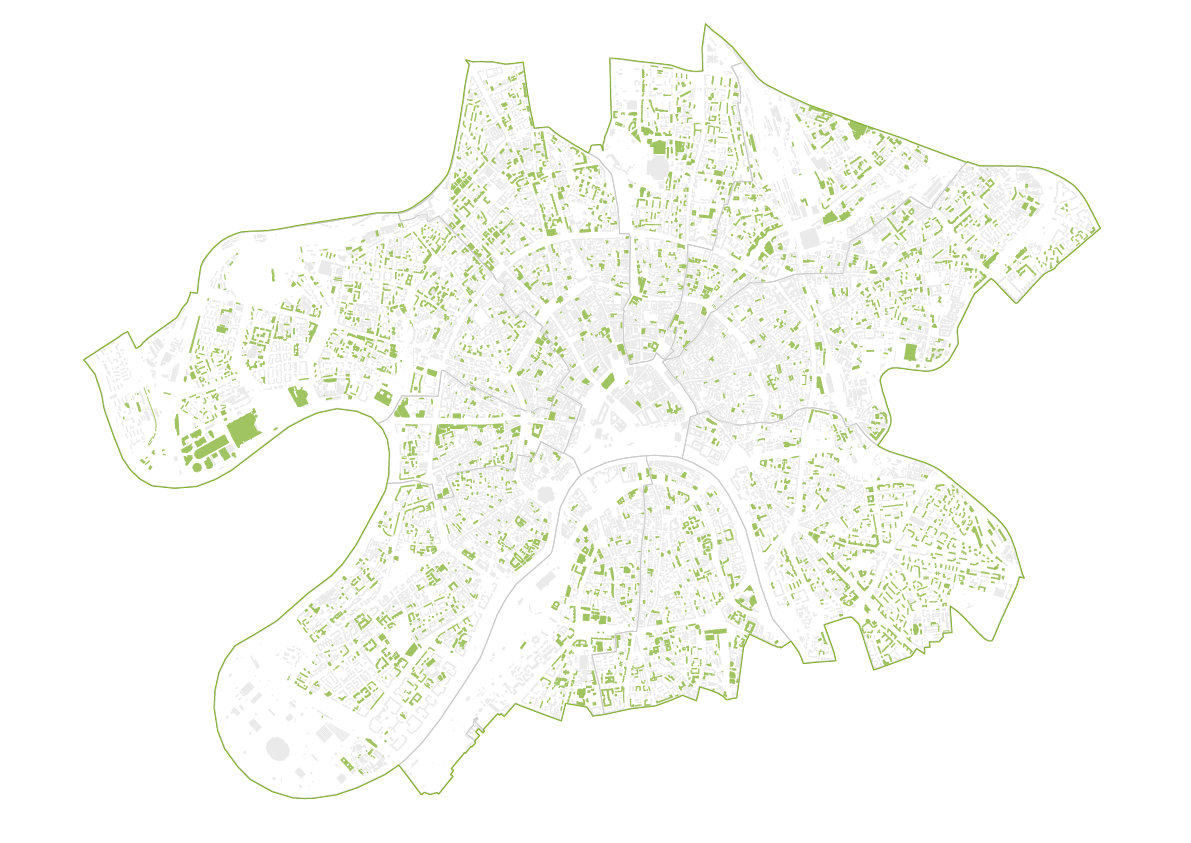
35%
Potential increase in the overall green space in the Central Administrative Okrug using green rooftops
overall area of rooftops
in the Central
Administrative Okrug
in the Central
Administrative Okrug
1566
A space equivalent
to 4 Gorky Parks is potentially
available for greening
to 4 Gorky Parks is potentially
available for greening

Greening rooftops will allow the city to solve the problem of neighbourhoods where there is a critical lack of green space, yet no space for new parks. Moscow's Central Administrative Okrug is the most obvious example: this area regularly experiences problems with street flooding, while dense construction, a large quantity of asphalt and a lack of green spaces leads to an increase
in the heat island effect.
in the heat island effect.
468,21
could potentially
be turned into green rooftops
be turned into green rooftops

hа


hа
CONTENTS
WHY ARE GREEN
ROOFTOPS RELEVANT
FOR MOSCOW TODAY?
ROOFTOPS RELEVANT
FOR MOSCOW TODAY?
GREEN ROOFTOPS
AS PROTECTION AGAINST CRISES
AS PROTECTION AGAINST CRISES
The key concept of the current pandemic period is distance. WHO experts implored people to observe physical distancing and limit visits to public spaces. A rooftop garden could become the ideal type of semi-public space that will help satisfy people's needs for leisure time in nature without violating necessary physical distancing measures.
A rooftop garden can be separated into zones, each of which can be reserved for use at a specific time by residents of a single apartment. This will allow visitors to the garden to avoid interacting during their designated leisure time, reducing the number of potential social contacts. Neighbours can agree on usage times over social networks or using a special application. Most importantly, a rooftop garden can already be organised through the joint efforts of building residents today.
A rooftop garden can be separated into zones, each of which can be reserved for use at a specific time by residents of a single apartment. This will allow visitors to the garden to avoid interacting during their designated leisure time, reducing the number of potential social contacts. Neighbours can agree on usage times over social networks or using a special application. Most importantly, a rooftop garden can already be organised through the joint efforts of building residents today.
Most importantly, a rooftop garden can already be organised through the joint efforts of building residents today.
The pandemic has shown that challenges for the city can be unpredictable and vary widely. In order to handle future crises, it is necessary to develop the city's sustainability. Green rooftops will help the city solve global problems by making it less vulnerable. The organizing and development of green rooftops will allow cities to improve their environmental situation and the health of their residents, solve the increasingly pressing problem of urban flooding, lower the loads placed on grey infrastructure and thereby decreasing expenses for its usage. In addition, the creation of new spaces for rent on urban roofs will open up new opportunities for small businesses, creating jobs and bringing the city additional income.
The pandemic has shown that challenges for the city can be unpredictable and vary widely. In order to handle future crises, it is necessary to develop the city's sustainability. Green rooftops will help the city solve global problems by making it less vulnerable. The organizing and development of green rooftops will allow cities to improve their environmental situation and the health of their residents, solve the increasingly pressing problem of urban flooding, lower the loads placed on grey infrastructure and thereby decreasing expenses for its usage. In addition, the creation of new spaces for rent on urban roofs will open up new opportunities for small businesses, creating jobs and bringing the city additional income.
The key concept of the current pandemic period is distance. WHO experts implored people to observe physical distancing and limit visits to public spaces. A rooftop garden could become the ideal type of semi-public space that will help satisfy people's needs for leisure time in nature without violating necessary physical distancing measures.
A rooftop garden can be separated into zones, each of which can be reserved for use at a specific time by residents of a single apartment. This will allow visitors to the garden to avoid interacting during their designated leisure time, reducing the number of potential social contacts. Neighbours can agree on usage times over social networks or using a special application. Most importantly, a rooftop garden can already be organised through the joint efforts of building residents today.
A rooftop garden can be separated into zones, each of which can be reserved for use at a specific time by residents of a single apartment. This will allow visitors to the garden to avoid interacting during their designated leisure time, reducing the number of potential social contacts. Neighbours can agree on usage times over social networks or using a special application. Most importantly, a rooftop garden can already be organised through the joint efforts of building residents today.
The key concept of the current pandemic period is distance. WHO experts implored people to observe physical distancing and limit visits to public spaces. A rooftop garden could become the ideal type of semi-public space that will help satisfy people's needs for leisure time in nature without violating necessary physical distancing measures.
A rooftop garden can be separated into zones, each of which can be reserved for use at a specific time by residents of a single apartment. This will allow visitors to the garden to avoid interacting during their designated leisure time, reducing the number of potential social contacts. Neighbours can agree on usage times over social networks or using a special application. Most importantly, a rooftop garden can already be organised through the joint efforts of building residents today.
A rooftop garden can be separated into zones, each of which can be reserved for use at a specific time by residents of a single apartment. This will allow visitors to the garden to avoid interacting during their designated leisure time, reducing the number of potential social contacts. Neighbours can agree on usage times over social networks or using a special application. Most importantly, a rooftop garden can already be organised through the joint efforts of building residents today.
The key concept of the current pandemic period is distance. WHO experts implored people to observe physical distancing and limit visits to public spaces. A rooftop garden could become the ideal type of semi-public space that will help satisfy people’s needs for leisure time in nature without violating necessary physical distancing measures.
A rooftop garden can be separated into zones, each of which can be reserved for use at a specific time by residents of a single apartment. This will allow visitors to the garden to avoid interacting during their designated leisure time, reducing the number of potential social contacts. Neighbours can agree on usage times over social networks or using a special application. Most importantly, a rooftop garden can already be organised through the joint efforts of building residents today.
Most importantly, a rooftop garden can already be organised through the joint efforts of building residents today.
The pandemic has shown that challenges for the city can be unpredictable and vary widely. In order to handle future crises, it is necessary to develop the city’s sustainability. Green rooftops will help the city solve global problems by making it less vulnerable. The organizing and development of green rooftops will allow cities to improve their environmental situation and the health of their residents, solve the increasingly pressing problem of urban flooding, lower the loads placed on grey infrastructure and thereby decreasing expenses for its usage. In addition, the creation of new spaces for rent on urban roofs will open up new opportunities for small businesses, creating jobs and bringing the city additional income.



PROBLEMS SOLVED
BY GREEN ROOFTOPS
BY GREEN ROOFTOPS
1. Flooding
1. Flooding
Due to global warming, the planet is experiencing the largest volume of precipitation of any period for which meteorological data has been collected. Like many other megapolises, Moscow is occasionally flooded by rainwater. If typical rainfall in our climate was previously lengthy and drizzly, near-tropical downpours have become almost a regularity due to the violation of the planet’s delicate environmental balance.
Such levels of precipitation cause mass transit accidents, ruin the lives of city residents and cause significant damage to the economy and environment. Rainwater gathers dust, trash and fuel residue from the streets that go on to find their way into rivers and groundwater.
The problem of removing excess water is solved by grey and green infrastructure. In its fight against heavy rain, Moscow is used to relying on grey infrastructure: storm drains, canals, sluices and other such tools. However, green infrastructure is no less important: rain gardens, parks and rivers. There are problems with these elements in Moscow, especially in the city centre, which is subject to the heaviest flooding of all during heavy rainfall and where there is simply no space whatsoever for new plantings.
Such levels of precipitation cause mass transit accidents, ruin the lives of city residents and cause significant damage to the economy and environment. Rainwater gathers dust, trash and fuel residue from the streets that go on to find their way into rivers and groundwater.
The problem of removing excess water is solved by grey and green infrastructure. In its fight against heavy rain, Moscow is used to relying on grey infrastructure: storm drains, canals, sluices and other such tools. However, green infrastructure is no less important: rain gardens, parks and rivers. There are problems with these elements in Moscow, especially in the city centre, which is subject to the heaviest flooding of all during heavy rainfall and where there is simply no space whatsoever for new plantings.
Due to global warming, the planet is experiencing the largest volume of precipitation of any period for which meteorological data has been collected. Like many other megapolises, Moscow is occasionally flooded by rainwater. If typical rainfall in our climate was previously lengthy and drizzly, near-tropical downpours have become almost a regularity due to the violation of the planet's delicate environmental balance.
Such levels of precipitation cause mass transit accidents, ruin the lives of city residents and cause significant damage to the economy and environment. Rainwater gathers dust, trash and fuel residue from the streets that go on to find their way into rivers and groundwater.
The problem of removing excess water is solved by grey and green infrastructure. In its fight against heavy rain, Moscow is used to relying on grey infrastructure: storm drains, canals, sluices and other such tools. However, green infrastructure is no less important: rain gardens, parks and rivers. There are problems with these elements in Moscow, especially in the city centre, which is subject to the heaviest flooding of all during heavy rainfall and where there is simply no space whatsoever for new plantings.
Such levels of precipitation cause mass transit accidents, ruin the lives of city residents and cause significant damage to the economy and environment. Rainwater gathers dust, trash and fuel residue from the streets that go on to find their way into rivers and groundwater.
The problem of removing excess water is solved by grey and green infrastructure. In its fight against heavy rain, Moscow is used to relying on grey infrastructure: storm drains, canals, sluices and other such tools. However, green infrastructure is no less important: rain gardens, parks and rivers. There are problems with these elements in Moscow, especially in the city centre, which is subject to the heaviest flooding of all during heavy rainfall and where there is simply no space whatsoever for new plantings.
1–2%
88
mm per meter per hour
fell in Moscow on 15 August 2016, which is equivalent to the monthly precipitation average 2
1,3
billion rubles
Spent on correcting the effects of heavy rain over 3 years 3
1. Alexander Chernokulsky et al 2019 Environ. Res. Lett. 14 45 001. (opscience.iop.org/article/10.1088/1748−9326/aafb82).
Detailed information about the study in Russian is available at:
nauka.tass.ru/nauka/6 334 565.
Detailed information about the study in Russian is available at:
nauka.tass.ru/nauka/6 334 565.
2. Detailed information in Russian is available at: В Москве в районе ВДНХ прошел самый сильный дождь
3. Detailed information in Russian is available at: https://tass.ru/moskva/3750791



Green infrastructure naturally passes on and retains water without leaving it on the surface thanks to porous surfaces. In parks and in green spaces, this is achieved using soil, plus root structures that absorb moisture from it. There are special zones like rain gardens, which are capable of taking up water in even greater volumes compared to a regular green zone, especially if hydrophilic vegetation is planted.
Porous surfaces also include gravel, paving stones with wide gaps filled with "screening" material, eco-pavement and selected other surface coverings. All of these allow water to easily filter through.
There is also a third class of sites, which we call hybrids. Such hybrids as green rooftops combine the advantages of both grey and green urban infrastructure.
There is also a third class of sites, which we call hybrids. Such hybrids as green rooftops combine the advantages of both grey and green urban infrastructure.
Green infrastructure naturally passes on and retains water without leaving it on the surface thanks to porous surfaces. In parks and in green spaces, this is achieved using soil, plus root structures that absorb moisture from it. There are special zones like rain gardens, which are capable of taking up water in even greater volumes compared to a regular green zone, especially if hydrophilic vegetation is planted.
Green infrastructure naturally passes on and retains water without leaving it on the surface thanks to porous surfaces. In parks and in green spaces, this is achieved using soil, plus root structures that absorb moisture from it. There are special zones like rain gardens, which are capable of taking up water in even greater volumes compared to a regular green zone, especially if hydrophilic vegetation is planted.
Green infrastructure naturally passes on and retains water without leaving it on the surface thanks to porous surfaces. In parks and in green spaces, this is achieved using soil, plus root structures that absorb moisture from it. There are special zones like rain gardens, which are capable of taking up water in even greater volumes compared to a regular green zone, especially if hydrophilic vegetation is planted.
Porous surfaces also include gravel, paving stones with wide gaps filled with "screening" material, eco-pavement and selected other surface coverings. All of these allow water to easily filter through.
There is also a third class of sites, which we call hybrids. Such hybrids as green rooftops combine the advantages of both grey and green urban infrastructure.
Porous surfaces also include gravel, paving stones with wide gaps filled with "screening" material, eco-pavement and selected other surface coverings. All of these allow water to easily filter through.
There is also a third class of sites, which we call hybrids. Such hybrids as green rooftops combine the advantages of both grey and green urban infrastructure.

In its fight against heavy rains, Moscow is accustomed to relying on grey infrastructure.

In its fight against heavy rains, Moscow is accustomed to relying on grey infrastructure.
2. Lack of green spaces
2. Lack of green spaces
Currently, the centre of Moscow suffers from a critical lack of green spaces, as do certain other districts in the city. In the centre of the capital, there are especially large quantities of asphalt and paving stones, dense construction and less green space than in other districts. Summer heat is felt more acutely here. In such conditions, we see the maximum possible effectiveness of green rooftops: city residents can have parks practically in their own homes. Of course, a green rooftop cannot replace a walk in a park, but it can serve as an excellent spot to relax, eat a leisurely breakfast or exercise outdoors within five minutes' walk from one's apartment door.
Currently, the centre of Moscow suffers from a critical lack of green spaces, as do certain other districts in the city. In the centre of the capital, there are especially large quantities of asphalt and paving stones, dense construction and less green space than in other districts. Summer heat is felt more acutely here. In such conditions, we see the maximum possible effectiveness of green rooftops: city residents can have parks practically in their own homes. Of course, a green rooftop cannot replace a walk in a park, but it can serve as an excellent spot to relax, eat a leisurely breakfast or exercise outdoors within five minutes' walk from one's apartment door.
per person: green space per person in the Arbat District (and this isn't the worst result among the ten neighborhoods in the Central Administrative Okrug!) 4
Per person: necessary allotment of green space per person in order to achieve a comfortable lifestyle 5
1,86 м2
16 м2
4. According to Strelka KB studies.
5. The standard is recorded in 42.13330.2011 Urban Development set of regulations. Planning and development of urban and rural settlements. Up-to-date version is available at: docs.cntd.ru/document/1200084712

IN THE CENTRAL ADMINISTRATIVE OKRUG:
- The worst environmental situation out of all the city's districts: in general, the city has slightly more green plantings than the global standard, but in the Central Administrative Okrug, the figure is much lower
- This area is hottest of all in the summer.
The difference between the city centre and the suburbs can reach up to 10°С - Extremely dense construction, many rooftops
and no space to create new parks - Critical transport infrastructure. Flooding of the Central Administrative Okrug in particular leads
to multi-kilometre traffic jams and an overcrowded metro

IN THE CENTRAL ADMINISTRATIVE OKRUG:
- The worst environmental situation out of all the city's districts: in general, the city has slightly more green plantings than the global standard, but in the Central Administrative Okrug, the figure is much lower
- This area is hottest of all in the summer.
The difference between the city centre and the suburbs can reach up to 10°С - Extremely dense construction, many rooftops
and no space to create new parks - Critical transport infrastructure. Flooding of the Central Administrative Okrug in particular leads
to multi-kilometre traffic jams and an overcrowded metro

IN THE CENTRAL ADMINISTRATIVE OKRUG:
- Худшая экологическая ситуация из всех округов: в среднем по городу количество зеленых насаждений чуть выше нормы, в ЦАО — сильно ниже
- Жарче всего летом. Разница между центром и пригородом может составлять до 10 °С
- Очень плотная застройка, много крыш и физически нет места для новых парков
- Критически важная транспортная инфраструктура. Именно затопление ЦАО периодически приводит к многокилометровым пробкам, переполненному метро
3. Environmental problems
3. Environmental problems
Greening rooftops is a strategy that helps reduce the "heat island" effect in major cities.
Causes of the "heat island" effect:
Causes of the "heat island" effect:
- Cities are a major source of greenhouse gases which cause the greenhouse effect;
- The continuous reduction of the percentage of urban land used as green spaces, resulting in the disruption of natural processes of cooling and evaporation;
- Large expanses of impermeable, heat-absorbing surfaces;
- Dense, tall construction leads to a disruption of proper air convection;
- Cities produce and emit large amounts of heat into the atmosphere.
Greening rooftops is a strategy that helps reduce the "heat island" effect in major cities.
Causes of the "heat island" effect:
Causes of the "heat island" effect:
- Cities are a major source of greenhouse gases which cause the greenhouse effect;
- The continuous reduction of the percentage of urban land used as green spaces, resulting in the disruption of natural processes of cooling and evaporation;
- Large expanses of impermeable, heat-absorbing surfaces;
- Dense, tall construction leads to a disruption of proper air convection;
- Cities produce and emit large amounts of heat into the atmosphere.
place
Moscow's position in the worldwide environmental rating of cities 6
91st
2–5°С
cooler on a green rooftop and underneath it than in Moscow on average during the summer 7
1,3°С
cooler on a green rooftop and underneath it than in Moscow on average during the summer heat 8
of waste water goes straight into Moscow River without any cleansing whatsoever, according to estimates by Strelka KB
47%
6. Quality of Life index by Numbeo. Environmental rating of Moscow — 61.32.
7. Razzaghmanesh, Mostafa & Beecham, Simon. (2015). The role of green roofs in mitigating Urban Heat Island effects in the metropolitan area of Adelaide, South Australia. Urban Forestry & Urban Greening. 15. 10.1016/j.ufug.2015.11.0130.
8. Sahnoune, Sara & Benhassine, Nassira. (2017). Quantifying the Impact of Green-Roofs on Urban Heat Island Mitigation. International Journal of Environmental Science and Development, Vol. 8, No. 2, February 2017. Modelling was made for the city of Constantine in Algeria. The results were achieved by greening of 50% city rooftops.
What are the negative consequences of the heat island effect and why is it worth fighting them?
- The heat island effect lowers air quality and leads to the formation of smog. Power inputs on indoor air conditioning and purification increase, as well as water usage for cooling and watering plants.
- Both the decrease in air quality and the increase in temperature cause and aggravate chronic illnesses among city residents. People with chronic illnesses, the aging and young children are especially sensitive to increases in temperature.⁹
The "heat island" effect is a temperature increase in the city relative to surrounding natural territories.
The temperature difference between these zones can reach up to 10−15°С.
The temperature difference between these zones can reach up to 10−15°С.
What are the negative consequences of the heat island effect and why is it worth fighting them?
- The heat island effect lowers air quality and leads to the formation of smog. Power inputs on indoor air conditioning and purification increase, as well as water usage for cooling and watering plants.
- Both the decrease in air quality and the increase in temperature cause and aggravate chronic illnesses among city residents. People with chronic illnesses, the aging and young children are especially sensitive to increases in temperature.
The "heat island" effect is a temperature increase in the city relative to surrounding natural territories.
The temperature difference between these zones can reach up to 10−15°С.
The temperature difference between these zones can reach up to 10−15°С.
What are the negative consequences of the heat island effect and why is it worth fighting them?
- The heat island effect lowers air quality and leads to the formation of smog. Power inputs on indoor air conditioning and purification increase, as well as water usage for cooling and watering plants.
- Both the decrease in air quality and the increase in temperature cause and aggravate chronic illnesses among city residents. People with chronic illnesses, the aging and young children are especially sensitive to increases in temperature.⁹
The "heat island" effect is a temperature increase in the city relative to surrounding natural territories.
The temperature difference between these zones can reach up to 10−15°С.
The temperature difference between these zones can reach up to 10−15°С.
9. Heatwaves in Europe's largest cities in 2003 are considered to be the reason for death of about 70.000 people. It stimulated local governments to develop the programs for reducing the heat island effects.
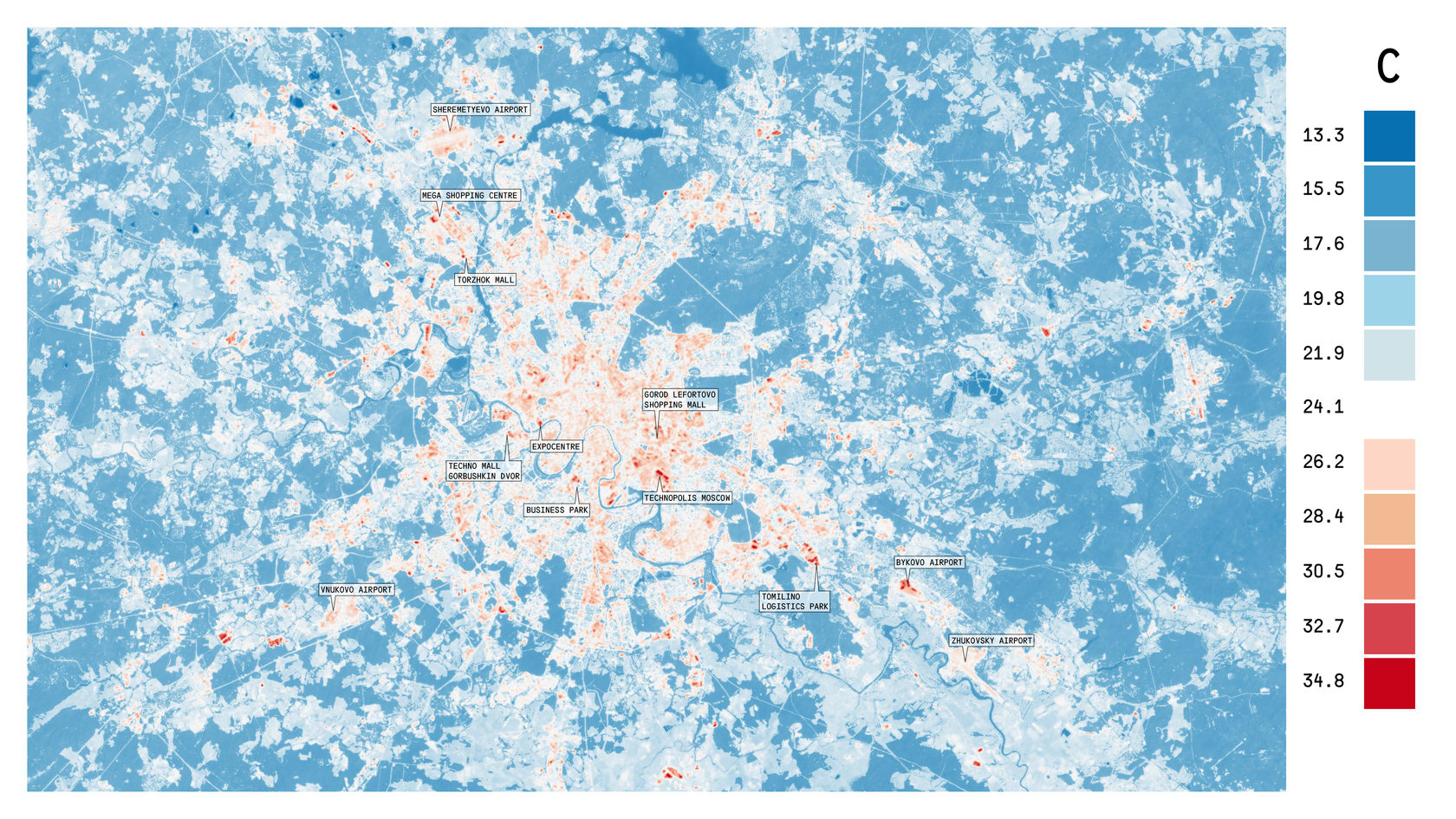
Green rooftops help purify runoff water. In passing through the layers of a green rooftop, water is purified. It does not reach the sidewalk and asphalt, but goes straight into a storm drain instead, which means that it does not collect fuel, oil and other damaging substances from the streets. Such water is far easier to purify than water collected from the city streets. Rain barrels and reservoirs can also be installed on rooftops. They can be used for utilitarian purposes, such as watering plants and washing sidewalks and facades. A green rooftop doesn't merely help lower temperatures on the hottest days, but also absorbs some of the city's noise and carbon dioxide. The more space is dedicated to green rooftops, the more significant the effect will be.
Visualization of the heat island effect in the centre of Moscow and around major infrastructure sites in June 2016, based on methods of remote land probing, computer processing of data from Landsat 8 and Strelka KB's GIS platform of urban statistics.

Visualization of the heat island effect in the centre of Moscow and around major infrastructure sites in June 2016, based on methods of remote land probing, computer processing of data from Landsat 8 and Strelka KB's GIS platform of urban statistics.
Green rooftops help purify runoff water. In passing through the layers of a green rooftop, water is purified. It does not reach the sidewalk and asphalt, but goes straight into a storm drain instead, which means that it does not collect fuel, oil and other damaging substances from the streets. Such water is far easier to purify than water collected from the city streets. Rain barrels and reservoirs can also be installed on rooftops. They can be used for utilitarian purposes, such as watering plants and washing sidewalks and facades. A green rooftop doesn't merely help lower temperatures on the hottest days, but also absorbs some of the city's noise and carbon dioxide. The more space is dedicated to green rooftops, the more significant the effect will be.
4. Unsustainable economy
4. Unsustainable economy
Green rooftops help reduce usage costs in the city. They work as an additional layer of thermal insulation: those rooms located directly underneath them do not heat up as much during the summer and lose less heat during the winter. This allows buildings to reduce air conditioning costs during the summer and heating costs in the winter. Green rooftops also improve waterproofing on rooftops, which means that repair works are needed less frequently. Collecting water in rain barrels and using it for watering plants and other utilitarian purposes allows for further savings on water supply and drainage.
Green rooftops can host cafes, public gardens, greenhouses, sports facilities, playgrounds, yoga studios or even libraries—all new opportunities for city residents to relax and build small business, which means new tax income for the city budget.
Green rooftops help reduce usage costs in the city. They work as an additional layer of thermal insulation: those rooms located directly underneath them do not heat up as much during the summer and lose less heat during the winter. This allows buildings to reduce air conditioning costs during the summer and heating costs in the winter. Green rooftops also improve waterproofing on rooftops, which means that repair works are needed less frequently. Collecting water in rain barrels and using it for watering plants and other utilitarian purposes allows for further savings on water supply and drainage.
Green rooftops can host cafes, public gardens, greenhouses, sports facilities, playgrounds, yoga studios or even libraries—all new opportunities for city residents to relax and build small business, which means new tax income for the city budget.
Green rooftops help reduce usage costs in the city. They work as an additional layer of thermal insulation: those rooms located directly underneath them do not heat up as much during the summer and lose less heat during the winter. This allows buildings to reduce air conditioning costs during the summer and heating costs in the winter. Green rooftops also improve waterproofing on rooftops, which means that repair works are needed less frequently. Collecting water in rain barrels and using it for watering plants and other utilitarian purposes allows for further savings on water supply and drainage.
Green rooftops can host cafes, public gardens, greenhouses, sports facilities, playgrounds, yoga studios or even libraries—all new opportunities for city residents to relax and build small business, which means new tax income for the city budget.

Brooklyn Grange, New York, USA,
The largest rooftop farm in the world. Produces 20 tonnes of vegetables every season, providing produce to local restaurants and grocery stores.
The largest rooftop farm in the world. Produces 20 tonnes of vegetables every season, providing produce to local restaurants and grocery stores.

Brooklyn Grange, New York, USA, The largest rooftop farm in the world. Produces 20 tonnes of vegetables every season, providing produce to local restaurants and grocery stores.
Farming can be an important element of the urban economy. As a result of "panic buying" during the COVID-19 pandemic, demand for food products exceeded the supply chain's standard capabilities. Store shelves stood empty. This situation sends out an important signal: in the future, it will be necessary to create more self-sufficient cities and neighbourhoods that can provide their residents with produce and necessary goods themselves. The use of urban spaces to grow fruit, vegetables, legumes, poultry, small livestock and even fish can serve as one of the solutions. Urban farms and greenhouses can be organised on the rooftops of buildings—a colossal expanse of unused spaces in the world's cities—and provide urban residents with direct access to fresh produce, which will allow them to avoid panic buying during global crises.
Urban farming can become a powerful economic stimulus for economies: it creates a new sector of the economy, which in turn brings new jobs for people who can take care of the plants. Farms can be used both by local residents for their personal needs as well as by businesses: restaurants can grow their own produce right on their own rooftops.
Urban farming can become a powerful economic stimulus for economies: it creates a new sector of the economy, which in turn brings new jobs for people who can take care of the plants. Farms can be used both by local residents for their personal needs as well as by businesses: restaurants can grow their own produce right on their own rooftops.

Hyundai Ioniq Hybrid, Up Top Acres, Washington, USA. This garden was organized by a commercial company. Residents can invest money at the beginning of the season and later, during the harvest period, receive shipments of fresh fruits and vegetables delivered right to their home.

Tedsans at ØsterGRO, Copenhagen, Denmark. Rooftop farm and restaurant. The restaurant prepares food from the produce that they themselves grow for its visitors.
Hyundai Ioniq Hybrid, Up Top Acres, Washington, USA. This garden was organized by a commercial company. Residents can invest money at the beginning of the season and later, during the harvest period, receive shipments of fresh fruits and vegetables delivered right to their home.

Farming can be an important element of the urban economy. As a result of "panic buying" during the COVID-19 pandemic, demand for food products exceeded the supply chain's standard capabilities. Store shelves stood empty. This situation sends out an important signal: in the future, it will be necessary to create more self-sufficient cities and neighbourhoods that can provide their residents with produce and necessary goods themselves. The use of urban spaces to grow fruit, vegetables, legumes, poultry, small livestock and even fish can serve as one of the solutions. Urban farms and greenhouses can be organised on the rooftops of buildings—a colossal expanse of unused spaces in the world's cities—and provide urban residents with direct access to fresh produce, which will allow them to avoid panic buying during global crises.
Urban farming can become a powerful economic stimulus for economies: it creates a new sector of the economy, which in turn brings new jobs for people who can take care of the plants. Farms can be used both by local residents for their personal needs as well as by businesses: restaurants can grow their own produce right on their own rooftops.
Urban farming can become a powerful economic stimulus for economies: it creates a new sector of the economy, which in turn brings new jobs for people who can take care of the plants. Farms can be used both by local residents for their personal needs as well as by businesses: restaurants can grow their own produce right on their own rooftops.

Tedsans at ØsterGRO, Copenhagen, Denmark. Rooftop farm and restaurant. The restaurant prepares food from the produce that they themselves grow for its visitors.
HOW ARE GREEN
ROOFTOPS ORGANISED?
ROOFTOPS ORGANISED?
3 TYPES OF GREEN ROOFTOPS
There are three main types of green rooftops: extensive, semi-intensive and intensive. This typology is based on the depth of the rooftop's substratum. On extensive rooftops, the substratum is not very deep, and grasses or sedums can be planted here. Semi-intensive rooftops with a slightly deeper substratum are suitable for growing shrubbery. Finally, on intensive rooftops, shrubbery and even trees can be planted: the substrata of such rooftops are fairly deep.
Intensive greenery may not be suitable for all rooftops for a number of reasons: for example, a deep substratum would increase the weight of the green rooftop. However, any type of rooftop can be turned into a rain garden, one of the tools for collecting rainwater. The garden will hold even more moisture if hydrophilic plants are planted there, all while accumulating and purifying water. The deeper the substratum in which plants are planted, the more water can be retained.
There are three main types of green rooftops: extensive, semi-intensive and intensive. This typology is based on the depth of the rooftop's substratum. On extensive rooftops, the substratum is not very deep, and grasses or sedums can be planted here. Semi-intensive rooftops with a slightly deeper substratum are suitable for growing shrubbery. Finally, on intensive rooftops, shrubbery and even trees can be planted: the substrata of such rooftops are fairly deep.
Intensive greenery may not be suitable for all rooftops for a number of reasons: for example, a deep substratum would increase the weight of the green rooftop. However, any type of rooftop can be turned into a rain garden, one of the tools for collecting rainwater. The garden will hold even more moisture if hydrophilic plants are planted there, all while accumulating and purifying water. The deeper the substratum in which plants are planted, the more water can be retained.
There are three main types of green rooftops: extensive, semi-intensive and intensive. This typology is based on the depth of the rooftop's substratum. On extensive rooftops, the substratum is not very deep, and grasses or sedums can be planted here. Semi-intensive rooftops with a slightly deeper substratum are suitable for growing shrubbery. Finally, on intensive rooftops, shrubbery and even trees can be planted: the substrata of such rooftops are fairly deep.
Intensive greenery may not be suitable for all rooftops for a number of reasons: for example, a deep substratum would increase the weight of the green rooftop. However, any type of rooftop can be turned into a rain garden, one of the tools for collecting rainwater. The garden will hold even more moisture if hydrophilic plants are planted there, all while accumulating and purifying water. The deeper the substratum in which plants are planted, the more water can be retained.
WHAT HAPPENS TO GREEN ROOFTOPS IN THE WINTER?
Cities like Stockholm, Oslo, Ottawa, Quebec and Edmonton are similar to Moscow in terms of climate and also experience cold winters. However, this does not stop local residents from actively working to green their rooftops. In order to let a green rooftop survive the winter and be ready for spring, it's enough to simply select plants which are suited to the local climate, focusing on hardy and undemanding cultivars.
Extensive rooftops require the least care of all, while intensive rooftops demand the same kind of care as any garden. Like in urban parks, flowers and grasses can be planted seasonally.
Cities like Stockholm, Oslo, Ottawa, Quebec and Edmonton are similar to Moscow in terms of climate and also experience cold winters. However, this does not stop local residents from actively working to green their rooftops. In order to let a green rooftop survive the winter and be ready for spring, it's enough to simply select plants which are suited to the local climate, focusing on hardy and undemanding cultivars.
Extensive rooftops require the least care of all, while intensive rooftops demand the same kind of care as any garden. Like in urban parks, flowers and grasses can be planted seasonally.
Cities like Stockholm, Oslo, Ottawa, Quebec and Edmonton are similar to Moscow in terms of climate and also experience cold winters. However, this does not stop local residents from actively working to green their rooftops. In order to let a green rooftop survive the winter and be ready for spring, it's enough to simply select plants which are suited to the local climate, focusing on hardy and undemanding cultivars.
Extensive rooftops require the least care of all, while intensive rooftops demand the same kind of care as any garden. Like in urban parks, flowers and grasses can be planted seasonally.
Extensive rooftops require the least care of all, while intensive rooftops demand the same kind of care as any garden. Like in urban parks, flowers and grasses can be planted seasonally.

Kiev, Ukraine

79&Park, Stockholm, Sweden

Hôtel du Vieux-Quebec , Quebec, Canada



79&Park, Stockholm, Sweden
Hôtel du Vieux-Quebec , Quebec, Canada
Kiev, Ukraine
HOW CAN YOU MAKE
A ROOFTOP GARDEN?
A ROOFTOP GARDEN?
Apartment owners in a residential building or the owner of a commercial building can try to green their rooftops independently. Such a rooftop can help to improve the environmental situation around the building, create a new leisure space for building residents and increase the price or rent of apartments.
HOW DO YOU START?

Step 1
Transition the rooftop into serviceable status. For this, you need the permission of all of the owners and tenants of the building, after which you can send a request to Rosreester to change the status of the rooftop. Practice has shown that this is the most complicated step.
Step 2
Transition the rooftop into serviceable status. For this, you need the permission of all of the owners and tenants of the building, after which you can send a request to Rosreester to change the status of the rooftop. Practice has shown that this is the most complicated step.
Step 3
Discuss what you would like to do with the rooftop with your neighbors and how much money you will need to invest into this shared task. It is important to choose the appropriate type of green rooftop, as well as plan out how you will fill the space and organise access to it. If there is a single owner of the building, they can make these decisions independently.
Transition the rooftop into serviceable status. For this, you need the permission of all of the owners and tenants of the building, after which you can send a request to Rosreester to change the status of the rooftop. Practice has shown that this is the most complicated step.
Step 2
Transition the rooftop into serviceable status. For this, you need the permission of all of the owners and tenants of the building, after which you can send a request to Rosreester to change the status of the rooftop. Practice has shown that this is the most complicated step.
Step 3
Discuss what you would like to do with the rooftop with your neighbors and how much money you will need to invest into this shared task. It is important to choose the appropriate type of green rooftop, as well as plan out how you will fill the space and organise access to it. If there is a single owner of the building, they can make these decisions independently.
Step 4
Sign the minutes of the residents' meeting and submit it to the Institute of Residential Planning (for example, the Moscow City Chamber of Notaries or the Moscow Scientific Research and Planning Institute of Typology and Experimental Planning), where a design will be prepared and approved at all the necessary levels of government.
Step 5
Make sure that the design corresponds to the technical and environmental demands of Construction Rules 17.13 330.2017, "Rooftops."
Step 6
Conduct a request for proposals and choose a contractor.
Step 7
Note the green rooftop on all necessary statements for the building and come to an agreement as to how its maintenance will be organised.
Sign the minutes of the residents' meeting and submit it to the Institute of Residential Planning (for example, the Moscow City Chamber of Notaries or the Moscow Scientific Research and Planning Institute of Typology and Experimental Planning), where a design will be prepared and approved at all the necessary levels of government.
Step 5
Make sure that the design corresponds to the technical and environmental demands of Construction Rules 17.13 330.2017, "Rooftops."
Step 6
Conduct a request for proposals and choose a contractor.
Step 7
Note the green rooftop on all necessary statements for the building and come to an agreement as to how its maintenance will be organised.
Step 1
Transition the rooftop into serviceable status. For this, you need the permission of all of the owners and tenants of the building, after which you can send a request to Rosreester to change the status of the rooftop. Practice has shown that this is the most complicated step.
Step 2
Transition the rooftop into serviceable status. For this, you need the permission of all of the owners and tenants of the building, after which you can send a request to Rosreester to change the status of the rooftop. Practice has shown that this is the most complicated step.
Step 3
Discuss what you would like to do with the rooftop with your neighbors and how much money you will need to invest into this shared task. It is important to choose the appropriate type of green rooftop, as well as plan out how you will fill the space and organise access to it. If there is a single owner of the building, they can make these decisions independently.
Transition the rooftop into serviceable status. For this, you need the permission of all of the owners and tenants of the building, after which you can send a request to Rosreester to change the status of the rooftop. Practice has shown that this is the most complicated step.
Step 2
Transition the rooftop into serviceable status. For this, you need the permission of all of the owners and tenants of the building, after which you can send a request to Rosreester to change the status of the rooftop. Practice has shown that this is the most complicated step.
Step 3
Discuss what you would like to do with the rooftop with your neighbors and how much money you will need to invest into this shared task. It is important to choose the appropriate type of green rooftop, as well as plan out how you will fill the space and organise access to it. If there is a single owner of the building, they can make these decisions independently.
Step 4
Sign the minutes of the residents' meeting and submit it to the Institute of Residential Planning (for example, the Moscow City Chamber of Notaries or the Moscow Scientific Research and Planning Institute of Typology and Experimental Planning), where a design will be prepared and approved at all the necessary levels of government.
Step 5
Make sure that the design corresponds to the technical and environmental demands of Construction Rules 17.13 330.2017, "Rooftops."
Step 6
Conduct a request for proposals and choose a contractor.
Step 7
Note the green rooftop on all necessary statements for the building and come to an agreement as to how its maintenance will be organised.
Sign the minutes of the residents' meeting and submit it to the Institute of Residential Planning (for example, the Moscow City Chamber of Notaries or the Moscow Scientific Research and Planning Institute of Typology and Experimental Planning), where a design will be prepared and approved at all the necessary levels of government.
Step 5
Make sure that the design corresponds to the technical and environmental demands of Construction Rules 17.13 330.2017, "Rooftops."
Step 6
Conduct a request for proposals and choose a contractor.
Step 7
Note the green rooftop on all necessary statements for the building and come to an agreement as to how its maintenance will be organised.
Step 1
Transition the rooftop into serviceable status. For this, you need the permission of all of the owners and tenants of the building, after which you can send a request to Rosreester to change the status of the rooftop. Practice has shown that this is the most complicated step.
Step 2
Transition the rooftop into serviceable status. For this, you need the permission of all of the owners and tenants of the building, after which you can send a request to Rosreester to change the status of the rooftop. Practice has shown that this is the most complicated step.
Step 3
Discuss what you would like to do with the rooftop with your neighbors and how much money you will need to invest into this shared task. It is important to choose the appropriate type of green rooftop, as well as plan out how you will fill the space and organise access to it. If there is a single owner of the building, they can make these decisions independently.
Step 4
Sign the minutes of the residents' meeting and submit it to the Institute of Residential Planning (for example, the Moscow City Chamber of Notaries or the Moscow Scientific Research and Planning Institute of Typology and Experimental Planning), where a design will be prepared and approved at all the necessary levels of government.
Step 5
Make sure that the design corresponds to the technical and environmental demands of Construction Rules 17.13 330.2017, "Rooftops."
Step 6
Conduct a request for proposals and choose a contractor.
Step 7
Note the green rooftop on all necessary statements for the building and come to an agreement as to how its maintenance will be organised.
Transition the rooftop into serviceable status. For this, you need the permission of all of the owners and tenants of the building, after which you can send a request to Rosreester to change the status of the rooftop. Practice has shown that this is the most complicated step.
Step 2
Transition the rooftop into serviceable status. For this, you need the permission of all of the owners and tenants of the building, after which you can send a request to Rosreester to change the status of the rooftop. Practice has shown that this is the most complicated step.
Step 3
Discuss what you would like to do with the rooftop with your neighbors and how much money you will need to invest into this shared task. It is important to choose the appropriate type of green rooftop, as well as plan out how you will fill the space and organise access to it. If there is a single owner of the building, they can make these decisions independently.
Step 4
Sign the minutes of the residents' meeting and submit it to the Institute of Residential Planning (for example, the Moscow City Chamber of Notaries or the Moscow Scientific Research and Planning Institute of Typology and Experimental Planning), where a design will be prepared and approved at all the necessary levels of government.
Step 5
Make sure that the design corresponds to the technical and environmental demands of Construction Rules 17.13 330.2017, "Rooftops."
Step 6
Conduct a request for proposals and choose a contractor.
Step 7
Note the green rooftop on all necessary statements for the building and come to an agreement as to how its maintenance will be organised.
CURRENT SOLUTIONS

In today's situation, where the majority of city residents are currently under quarantine, green rooftops have become especially relevant. What can you do if it will take some time to organise a full-fledged green rooftop, but you need an alternative leisure spot right now?
You can use contained greening, like potted plants and wooden crates. You can grow both decorative plants and useful crops like herbs and vegetables in them. For furniture, you can use shipping pallets and movable garden furniture. To cover the rooftop, you can use rock chips, wood chips or decking. If there isn't much space on the rooftop, contained plantings can be stacked on top of each other or you can create vertical greening. Grapes and other vine plants work well for this. During the pandemic, it is important to organise the space to allow people to maintain social distancing. For this, you need to divide the space into functional zones with movable containers. If there are several entryways in the building, you need to create separate segments for each of them. That way, the number of users of a single segment will be limited.
You can use contained greening, like potted plants and wooden crates. You can grow both decorative plants and useful crops like herbs and vegetables in them. For furniture, you can use shipping pallets and movable garden furniture. To cover the rooftop, you can use rock chips, wood chips or decking. If there isn't much space on the rooftop, contained plantings can be stacked on top of each other or you can create vertical greening. Grapes and other vine plants work well for this. During the pandemic, it is important to organise the space to allow people to maintain social distancing. For this, you need to divide the space into functional zones with movable containers. If there are several entryways in the building, you need to create separate segments for each of them. That way, the number of users of a single segment will be limited.
It is important to provide for antiseptic treatments of all surfaces on the roof. The most important factor, however, is that residents must agree on the order in which they will use each zone. For this, they can use social networks, a special app or a dedicated site.
In the future, this temporary solution may be augmented by an extensive rooftop that can go on to become a full-fledged rooftop park. In this case, wooden crates will rot and become overgrown with time, creating natural hills. Such a solution will turn out to be cheaper than intensive greening of the entire rooftop, while leaving the possibility for planting taller plants.
Unlike a courtyard, the user community for green rooftops is limited to the residents of a single building or entryway, who have the right to use the space sequentially and thereby make it a safe place—even during a pandemic.
In the future, this temporary solution may be augmented by an extensive rooftop that can go on to become a full-fledged rooftop park. In this case, wooden crates will rot and become overgrown with time, creating natural hills. Such a solution will turn out to be cheaper than intensive greening of the entire rooftop, while leaving the possibility for planting taller plants.
Unlike a courtyard, the user community for green rooftops is limited to the residents of a single building or entryway, who have the right to use the space sequentially and thereby make it a safe place—even during a pandemic.
In today's situation, where the majority of city residents are currently under quarantine, green rooftops have become especially relevant. What can you do if it will take some time to organise a full-fledged green rooftop, but you need an alternative leisure spot right now?
You can use contained greening, like potted plants and wooden crates. You can grow both decorative plants and useful crops like herbs and vegetables in them. For furniture, you can use shipping pallets and movable garden furniture. To cover the rooftop, you can use rock chips, wood chips or decking. If there isn't much space on the rooftop, contained plantings can be stacked on top of each other or you can create vertical greening. Grapes and other vine plants work well for this. During the pandemic, it is important to organise the space to allow people to maintain social distancing. For this, you need to divide the space into functional zones with movable containers. If there are several entryways in the building, you need to create separate segments for each of them. That way, the number of users of a single segment will be limited.
You can use contained greening, like potted plants and wooden crates. You can grow both decorative plants and useful crops like herbs and vegetables in them. For furniture, you can use shipping pallets and movable garden furniture. To cover the rooftop, you can use rock chips, wood chips or decking. If there isn't much space on the rooftop, contained plantings can be stacked on top of each other or you can create vertical greening. Grapes and other vine plants work well for this. During the pandemic, it is important to organise the space to allow people to maintain social distancing. For this, you need to divide the space into functional zones with movable containers. If there are several entryways in the building, you need to create separate segments for each of them. That way, the number of users of a single segment will be limited.
It is important to provide for antiseptic treatments of all surfaces on the roof. The most important factor, however, is that residents must agree on the order in which they will use each zone. For this, they can use social networks, a special app or a dedicated site.
In the future, this temporary solution may be augmented by an extensive rooftop that can go on to become a full-fledged rooftop park. In this case, wooden crates will rot and become overgrown with time, creating natural hills. Such a solution will turn out to be cheaper than intensive greening of the entire rooftop, while leaving the possibility for planting taller plants.
Unlike a courtyard, the user community for green rooftops is limited to the residents of a single building or entryway, who have the right to use the space sequentially and thereby make it a safe place—even during a pandemic.
In the future, this temporary solution may be augmented by an extensive rooftop that can go on to become a full-fledged rooftop park. In this case, wooden crates will rot and become overgrown with time, creating natural hills. Such a solution will turn out to be cheaper than intensive greening of the entire rooftop, while leaving the possibility for planting taller plants.
Unlike a courtyard, the user community for green rooftops is limited to the residents of a single building or entryway, who have the right to use the space sequentially and thereby make it a safe place—even during a pandemic.
In today's situation, where the majority of city residents are currently under quarantine, green rooftops have become especially relevant. What can you do if it will take some time to organise a full-fledged green rooftop, but you need an alternative leisure spot right now?
You can use contained greening, like potted plants and wooden crates. You can grow both decorative plants and useful crops like herbs and vegetables in them. For furniture, you can use shipping pallets and movable garden furniture. To cover the rooftop, you can use rock chips, wood chips or decking. If there isn't much space on the rooftop, contained plantings can be stacked on top of each other or you can create vertical greening. Grapes and other vine plants work well for this. During the pandemic, it is important to organise the space to allow people to maintain social distancing. For this, you need to divide the space into functional zones with movable containers. If there are several entryways in the building, you need to create separate segments for each of them. That way, the number of users of a single segment will be limited.
It is important to provide for antiseptic treatments of all surfaces on the roof. The most important factor, however, is that residents must agree on the order in which they will use each zone. For this, they can use social networks, a special app or a dedicated site.
In the future, this temporary solution may be augmented by an extensive rooftop that can go on to become a full-fledged rooftop park. In this case, wooden crates will rot and become overgrown with time, creating natural hills. Such a solution will turn out to be cheaper than intensive greening of the entire rooftop, while leaving the possibility for planting taller plants.
Unlike a courtyard, the user community for green rooftops is limited to the residents of a single building or entryway, who have the right to use the space sequentially and thereby make it a safe place—even during a pandemic.
University of the Arts, Zurich, Switzerland
A rooftop garden with softscape elements in crates. Over time, the crates will rot and become natural hills. In this way, temporary greening can become a part of the permanent landscape.
A rooftop garden with softscape elements in crates. Over time, the crates will rot and become natural hills. In this way, temporary greening can become a part of the permanent landscape.

A rooftop garden with homemade containers for plants and outdoor furniture. Such a solution is easy to implement independently.
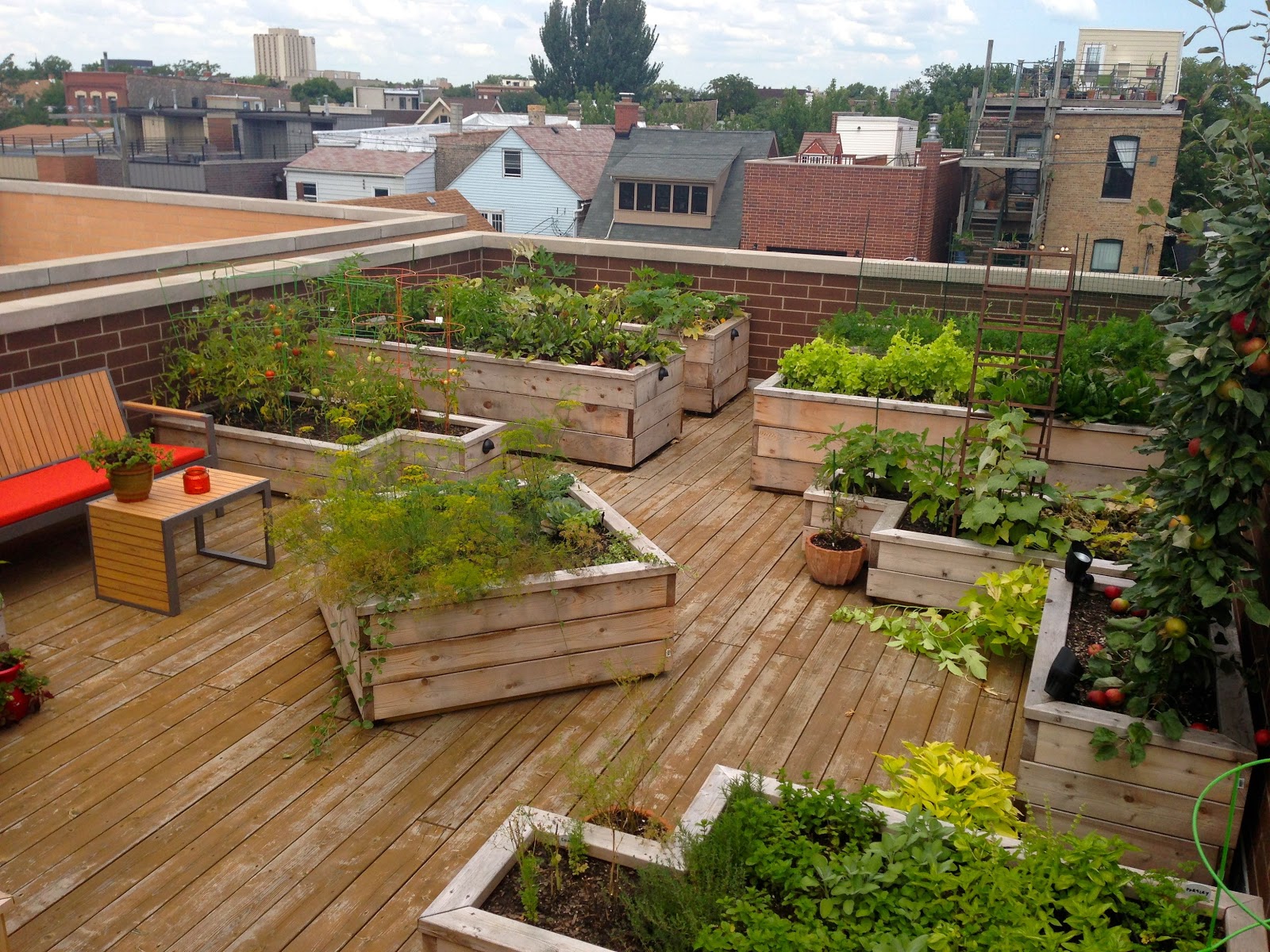

University of the Arts, Zurich, Switzerland
A rooftop garden with softscape elements in crates. Over time, the crates will rot and become natural hills. In this way, temporary greening can become a part of the permanent landscape.
A rooftop garden with softscape elements in crates. Over time, the crates will rot and become natural hills. In this way, temporary greening can become a part of the permanent landscape.
A rooftop garden with homemade containers for plants and outdoor furniture. Such a solution is easy to implement independently.
The roof of a building is an opportunity to create a new courtyard free of strangers and cars, where you can relax and grow vegetables without leaving your house.
The roof of a building is an opportunity to create a new courtyard free of strangers and cars, where you can relax and grow vegetables without leaving your house.
What can you do if your building's rooftop is not flat,
but sloped—or too old to be greened?
but sloped—or too old to be greened?
What can you do if your building's rooftop is not flat, but sloped—or too old to be greened?

Playground and athletic facilities on a garage rooftop, Copenhagen, Denmark

University of Melbourne's Burnley Campus, Melbourne, Australia

Nathan Phillips Square and Podium at the Toronto City Hall, Toronto, Canada
One solution is to create similar green rooftops on nearby empty shopping centres, offices, universities, libraries and public garages.
During the current quarantine period, they can be used according to the same principles as rooftops of residential buildings. This means that only residents of nearby buildings can visit them after making an advance reservation and with strict limits on the number of people using the rooftop. In the future, these temporary rooftops can be turned into permanent onces.
During the current quarantine period, they can be used according to the same principles as rooftops of residential buildings. This means that only residents of nearby buildings can visit them after making an advance reservation and with strict limits on the number of people using the rooftop. In the future, these temporary rooftops can be turned into permanent onces.
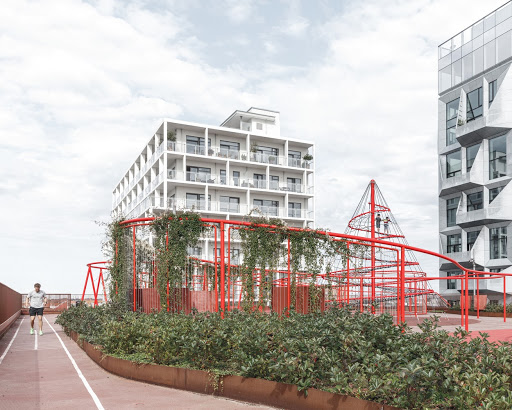
Playground and athletic facilities on a garage rooftop, Copenhagen, Denmark

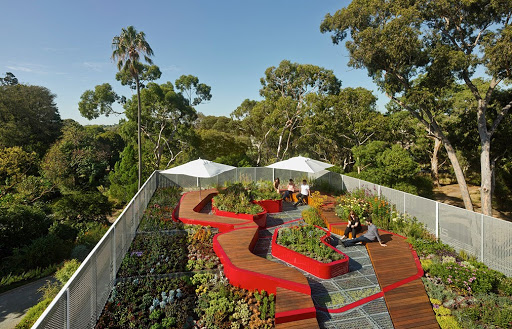
Nathan Phillips Square and Podium at the Toronto City Hall, Toronto, Canada
University of Melbourne's Burnley Campus, Melbourne, Australia
WORLDWIDE EXPERIENCE
Green rooftops have been successfully implemented in many cities around the world. These practices have mainly been incorporated into strategies of urban development, but there are also examples of state-level programmes. For example, China has a large-scale state programme to adapt cities for climate change that includes green rooftops. The programme began with 13 cities, including Beijing and Shanghai, and similar techniques are already being used in 30 cities around China.
Green rooftops have been successfully implemented in many cities around the world. These practices have mainly been incorporated into strategies of urban development, but there are also examples of state-level programmes. For example, China has a large-scale state programme to adapt cities for climate change that includes green rooftops. The programme began with 13 cities, including Beijing and Shanghai, and similar techniques are already being used in 30 cities around China.
GREENING STRATEGIES
The launch of such a project always depends on the interaction between city power structures and building owners: the former change urban planning standards and introduce incentives and subsidies for green infrastructure, while the latter invest in green rooftops and thereby increase the value of their real estate while getting new rentable spaces.
City administrations can speed the adoption of green rooftops in various ways. Here are the primary ones today:
Recommendations and requirements. to green all rooftops (Stuttgart, Germany) / rooftops with up to a 30-degree incline (Copenhagen, Denmark) / only flat rooftops on new construction (Basel, Switzerland).
City administrations can speed the adoption of green rooftops in various ways. Here are the primary ones today:
Recommendations and requirements. to green all rooftops (Stuttgart, Germany) / rooftops with up to a 30-degree incline (Copenhagen, Denmark) / only flat rooftops on new construction (Basel, Switzerland).
Subsidy and grant programmes. In Stuttgart, up to 50% of expenses on erecting rooftop structures are compensated, and in London, there is a system of grants for private projects.
Green index. In London, developers must enact a series of greening and rainwater drainage measures, each of which is evaluated. In order to receive permission to build, a barrier set on a district-by-district basis must be met. Similar indexes are in effect in Berlin, Hamburg, Malmo, Helsinki, Seattle, Washington and other cities.
Changing the tariff policy. In Philadelphia, there is a flexible tariff structure for water drainage. This is a stimulus for those who drain the largest amounts of water to create green infrastructure elements in order to reduce their payments. In Munster, for example, the presence of a green rooftop gives building owners a discount on water drainage rates.
Green index. In London, developers must enact a series of greening and rainwater drainage measures, each of which is evaluated. In order to receive permission to build, a barrier set on a district-by-district basis must be met. Similar indexes are in effect in Berlin, Hamburg, Malmo, Helsinki, Seattle, Washington and other cities.
Changing the tariff policy. In Philadelphia, there is a flexible tariff structure for water drainage. This is a stimulus for those who drain the largest amounts of water to create green infrastructure elements in order to reduce their payments. In Munster, for example, the presence of a green rooftop gives building owners a discount on water drainage rates.
The launch of such a project always depends on the interaction between city power structures and building owners: the former change urban planning standards and introduce incentives and subsidies for green infrastructure, while the latter invest in green rooftops and thereby increase the value of their real estate while getting new rentable spaces.
City administrations can speed the adoption of green rooftops in various ways. Here are the primary ones today:
Recommendations and requirements. to green all rooftops (Stuttgart, Germany) / rooftops with up to a 30-degree incline (Copenhagen, Denmark) / only flat rooftops on new construction (Basel, Switzerland).
City administrations can speed the adoption of green rooftops in various ways. Here are the primary ones today:
Recommendations and requirements. to green all rooftops (Stuttgart, Germany) / rooftops with up to a 30-degree incline (Copenhagen, Denmark) / only flat rooftops on new construction (Basel, Switzerland).
Subsidy and grant programmes. In Stuttgart, up to 50% of expenses on erecting rooftop structures are compensated, and in London, there is a system of grants for private projects.
Green index. In London, developers must enact a series of greening and rainwater drainage measures, each of which is evaluated. In order to receive permission to build, a barrier set on a district-by-district basis must be met. Similar indexes are in effect in Berlin, Hamburg, Malmo, Helsinki, Seattle, Washington and other cities.
Changing the tariff policy. In Philadelphia, there is a flexible tariff structure for water drainage. This is a stimulus for those who drain the largest amounts of water to create green infrastructure elements in order to reduce their payments. In Munster, for example, the presence of a green rooftop gives building owners a discount on water drainage rates.
Green index. In London, developers must enact a series of greening and rainwater drainage measures, each of which is evaluated. In order to receive permission to build, a barrier set on a district-by-district basis must be met. Similar indexes are in effect in Berlin, Hamburg, Malmo, Helsinki, Seattle, Washington and other cities.
Changing the tariff policy. In Philadelphia, there is a flexible tariff structure for water drainage. This is a stimulus for those who drain the largest amounts of water to create green infrastructure elements in order to reduce their payments. In Munster, for example, the presence of a green rooftop gives building owners a discount on water drainage rates.
The launch of such a project always depends on the interaction between city power structures and building owners: the former change urban planning standards and introduce incentives and subsidies for green infrastructure, while the latter invest in green rooftops and thereby increase the value of their real estate while getting new rentable spaces.
City administrations can speed the adoption of green rooftops in various ways. Here are the primary ones today:
Recommendations and requirements. to green all rooftops (Stuttgart, Germany) / rooftops with up to a 30-degree incline (Copenhagen, Denmark) / only flat rooftops on new construction (Basel, Switzerland).
Subsidy and grant programmes. In Stuttgart, up to 50% of expenses on erecting rooftop structures are compensated, and in London, there is a system of grants for private projects.
Green index. In London, developers must enact a series of greening and rainwater drainage measures, each of which is evaluated. In order to receive permission to build, a barrier set on a district-by-district basis must be met. Similar indexes are in effect in Berlin, Hamburg, Malmo, Helsinki, Seattle, Washington and other cities.
Changing the tariff policy. In Philadelphia, there is a flexible tariff structure for water drainage. This is a stimulus for those who drain the largest amounts of water to create green infrastructure elements in order to reduce their payments. In Munster, for example, the presence of a green rooftop gives building owners a discount on water drainage rates.
City administrations can speed the adoption of green rooftops in various ways. Here are the primary ones today:
Recommendations and requirements. to green all rooftops (Stuttgart, Germany) / rooftops with up to a 30-degree incline (Copenhagen, Denmark) / only flat rooftops on new construction (Basel, Switzerland).
Subsidy and grant programmes. In Stuttgart, up to 50% of expenses on erecting rooftop structures are compensated, and in London, there is a system of grants for private projects.
Green index. In London, developers must enact a series of greening and rainwater drainage measures, each of which is evaluated. In order to receive permission to build, a barrier set on a district-by-district basis must be met. Similar indexes are in effect in Berlin, Hamburg, Malmo, Helsinki, Seattle, Washington and other cities.
Changing the tariff policy. In Philadelphia, there is a flexible tariff structure for water drainage. This is a stimulus for those who drain the largest amounts of water to create green infrastructure elements in order to reduce their payments. In Munster, for example, the presence of a green rooftop gives building owners a discount on water drainage rates.

A more systematic approach is used in London, where the overall green rooftop area was doubled over 10 years, from 71.5 ha to 151 ha. Both rooftops and walls are made green. The city conducted several large-scale studies in order to calculate the economic value of its natural resources, as well as assessing the impact of greening (and its absence) on the health of city residents and the urban economy.
For example, it became apparent that each pound spent by the government on greening resulted in £27 worth of new business, services and amenities for city residents, while the very same residents save nearby £1 billion a year on healthcare thanks to improvements to the environmental status of the city.
A more systematic approach is used in London, where the overall green rooftop area was doubled over 10 years, from 71.5 ha to 151 ha. Both rooftops and walls are made green. The city conducted several large-scale studies in order to calculate the economic value of its natural resources, as well as assessing the impact of greening (and its absence) on the health of city residents and the urban economy.
For example, it became apparent that each pound spent by the government on greening resulted in £27 worth of new business, services and amenities for city residents, while the very same residents save nearby £1 billion a year on healthcare thanks to improvements to the environmental status of the city.
A more systematic approach is used in London, where the overall green rooftop area was doubled over 10 years, from 71.5 ha to 151 ha. Both rooftops and walls are made green. The city conducted several large-scale studies in order to calculate the economic value of its natural resources, as well as assessing the impact of greening (and its absence) on the health of city residents and the urban economy.
For example, it became apparent that each pound spent by the government on greening resulted in £27 worth of new business, services and amenities for city residents, while the very same residents save nearby £1 billion a year on healthcare thanks to improvements to the environmental status of the city.
For example, it became apparent that each pound spent by the government on greening resulted in £27 worth of new business, services and amenities for city residents, while the very same residents save nearby £1 billion a year on healthcare thanks to improvements to the environmental status of the city.
7 FACTS ABOUT
GREEN ROOFTOPS
GREEN ROOFTOPS
Organising green rooftops can solve current problems connected to the worldwide pandemic in cities. Building rooftops can become new safe and semi-private spaces for leisure, exercise and walks in the fresh air.
Green rooftops keep up with contemporary trends and priorities in developing societies and cities. Among other things, they enable improvements in both the physical and mental health of city residents.
1
Greening rooftops allows cities to solve their environmental and infrastructural problems. Alongside other measures, it helps improve air and water quality, provides protection from flooding and minimises the negative impact of the "heat island" effect. These intentions will remain relevant for cities even after the pandemic is over.
Green rooftops can make a city more crisis-resistant and self-sufficient. It is possible to use rooftops to grow fruit, vegetables and herbs within the city limits, which shortens produce supply chains and helps cities prepare for all different kinds of cataclysms.
Green rooftops allow both the city and its various users to save their money while allowing the urban economy to develop and creating new jobs.
When the rules for development and regular care are followed, a green rooftop can function properly, survive the harshest winters and bring joy to its future owners for a long time to come.
The rooftop greening process can already begin today, in the midst of the pandemic. For this, all that is necessary is the initiative of city residents along with their close attention to safety rules, greening recommendations and the regulations of the city administration for maintaining social distancing regulations.
2
3
4
5
7
6
Share
Illustrations: Evgenia Varayun. Photographs: Iwan Baan for Strelka KB, Shlomo Aronson Architects ltd., Texas A&M's Green Roof Project, ZinCo, Pukhov K/Shutterstock, Legion-Media, byothe/Pixabay, franswillemblok/iStock.